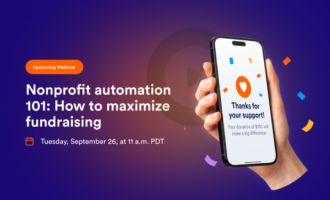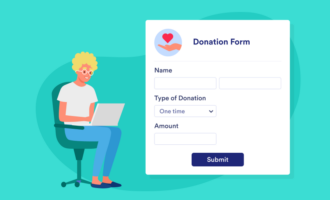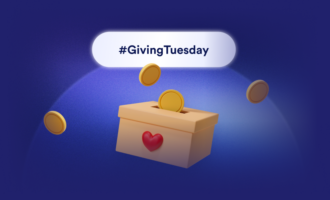Nonprofit organizations across the country perform good works like caring for shelter animals, transporting dialysis patients, tutoring underprivileged children, and more. Some 63 million Americans volunteer in their communities each year. Yet most volunteer programs wouldn’t exist without the financial foundation built through nonprofit fundraising.
Nonprofit fundraising involves asking people to support an organization and its mission financially. In the U.S., it’s a significant effort that reaps significant rewards. In 2019, fundraising on behalf of nonprofit organizations garnered as much as $449.64 billion.
Whether you’re new to nonprofit fundraising or just looking to improve your fundraising efforts, you’ll find the ideas you need to run a successful campaign. See the chapter synopsis below to find the topic that interests you, all while learning best practices from nonprofit fundraising experts.
Chapter synopsis
- Introduction
- What is fundraising? Explore the concept of fundraising and why nonprofit fundraising is so crucial to charitable organizations.
- How to create a successful fundraising plan. Learn how to align your organization’s goals with its mission to create a successful fundraising plan.
- Which nonprofit fundraising strategy is right for you? Discover some of the primary strategies to increase fundraising, from face-to-face contact to telephone outreach. Plus, find out why you should be applying for grants.
- Online fundraising for nonprofits. Everyone is online and connected, and your nonprofit should be too. Explore how different online fundraising approaches can serve your organization’s needs and how you can create virtual fundraising events.
- Developing a donor retention strategy. Nurturing your relationship with existing donors is important to the financial health of your nonprofit organization. Read about a variety of tools and tips for receiving recurring donations.
Remember to bookmark this guide for later reference.
What is fundraising?
We’ve already noted that fundraising involves asking for money and that billions are raised for nonprofit organizations in the United States. Now let’s talk in detail about fundraising for nonprofits.
What is fundraising, and how is it different from nonprofit fundraising?
“Fundraising is the ability to ask community members and donors to participate in the passion you have for your mission, whatever your mission is,” explains Bernadette Rexford of the Benedictine Health Foundation. “People support your cause through fundraising events, year-end events, or donor appeals.”
What is nonprofit fundraising, then? Nonprofit fundraising involves soliciting and then collecting money to sustain a charitable or nonprofit organization.
Businesses, philanthropic groups, families, individuals, and government agencies can provide funds to nonprofits. Nonprofit organizations fundraise in various ways, from online appeals and printed mailers to radio and TV ads and in-person events.
Fundraising is vital for nonprofit organizations because it’s often their primary source of income to cover expenses, including those for projects, grants, and administrative costs.
The changing nonprofit environment
Nonprofit fundraising statistics reveal that the fundraising landscape is continually evolving. A consistent theme is the growing importance of sharing messages and raising funds via online platforms like websites and social media, as well as mobile devices through text-to-donate campaigns.
According to nonprofit fundraising statistics from the 2021 M+R Benchmarks Study
- In 2020, nonprofit organizations experienced a 32 percent increase in revenue from online sources over 2019.
- From 2019 to 2020, Instagram was the fastest-growing social media platform for nonprofits, seeing a 25 percent increase in the number of followers. Twitter followers of nonprofits grew by 5 percent, and the nonprofit following on Facebook saw 3 percent growth.
- In 2020, subscribers to nonprofit text messages grew by 26 percent.
- Users on mobile devices accounted for half of all nonprofit website visits in 2020.
- From 2019 to 2020, the traffic share for mobile devices increased by 9 percent.
- Organic website visitors, or those who come to a site through search engine results, represented 42 percent of all nonprofit website traffic in 2020.
- Monthly donations totaled 19 percent of all online revenue in 2020.
11 nonprofit fundraising best practices
If your nonprofit organization is just beginning fundraising, or if it simply wants to improve its approach, seasoned fundraisers can offer nonprofit fundraising best practices to make your journey easier and more profitable.
Rexford, Susan Rizzo Vincent of The Andréa Rizzo Foundation and Drea’s Dream, and Emily DeGasperis of the Junior League of Kingston, New York, share their best practices for nonprofit fundraising below:
- Branch out. Whether researching grant applications or sharing the mission and vision of your organization, “explore every opportunity,” says Rexford.
- Surround yourself with experienced fundraisers. Rexford says, “Whether they’re committee members, board members, or friends, you need good people to bounce ideas off.”
- Seek person-to-person contact. “You have to be the person who’s willing to go out there and say, ‘Hey, I’m so-and-so, and I’d like to have coffee with you,’ ” says Rexford. Find out the hopes and dreams of the community and how your nonprofit can serve them. DeGasperis agrees that fundraising isn’t for introverts.
- Have a passion for the organization. “You can always tell when someone is passionate about the organization they represent,” says DeGasperis.
- Share stories about the organization’s good work. “At board meetings, I always share two or three testimonials at the end of the meeting,” Rexford explains. “It’s important for volunteers to know these are the folks we touch. This is really why we’re here.”
- Appreciate your volunteers. Remember to recognize the accomplishments of volunteers. According to DeGasperis, “in a small nonprofit, a lot of the work is done by volunteers.”
- Keep it simple. Although many nonprofits host complex fundraisers, such as gala receptions offering food, performances, and raffles, not every event requires multiple moving parts. Vincent tells her potential fundraisers to keep it simple.
- Institute the right processes. The volunteers helping with fundraising often have full-time jobs and aren’t located in the same office, so it’s important to streamline your processes. Coordination and ensuring that everyone is on the same page contributes to campaign success.
- Recruit reliable, capable people. From PR for an event to creating a custom recognition plaque, Vincent knows the work will get done. “They don’t need constant supervision,” she explains.
- Use one work platform. When people are working remotely to plan events, use one online platform for minutes and notes to save time and decrease stress.
- Be bold and make the ask. Asking is never easy, DeGasperis says. “But the more confidence you have in your cause, the more comfortable you’ll be in getting in front of people to talk about the work you’re doing — and the more successful at fundraising you’ll be.”
Now that you understand more about nonprofit fundraising and the best practices for pursuing it, let’s move on to creating a successful fundraising plan.
How to create a successful fundraising plan
A nonprofit fundraising plan details how your organization will raise funds in one or more years. The fundraising plan states — and aligns with — your organization’s mission. It also details your fundraising goals, your allotted budget, your timeline, and your fundraising methods.
Fundraising mission
The overall mission of your nonprofit organization explains your purpose and the role you strive to play in the community — or even the country and the world. Often called a mission statement, it expresses your aims and values. In plain words, it answers the questions, why does your organization exist, and whom do you serve?
The fundraising mission serves the overall mission of your nonprofit organization. It focuses on all of the fundraising activities and efforts you undertake and ensures they align with the overall mission of the organization.
Again, remember who the organization serves and why. “Realistically, your biggest supporters will be people who have a personal connection with your mission,” says DeGasperis.
Fundraising goals
The first step to creating a successful nonprofit fundraising plan is to determine your goals: both the organization’s goals and the goals specifically for fundraising. The organization’s goals explain why you want to raise funds. The fundraising goals explain how much you want to raise.
It’s important that organizational goals — the why — align with your mission. One approach to ensuring they align is to appeal to donors’ empathy.
Rexford, whose company provides financial support to local cancer patients, says “Everybody knows someone who’s in diagnosis or who went through treatment. We’re a small organization, but we’re very grassroots. I think that’s why we get a lot of local funding and support. What’s raised here stays here.”
Fundraising goals — the how much — should focus on a specific, measurable target amount, which is ambitious but attainable.
Fundraising budget
Understanding your costs is the foundation of establishing a fundraising budget. Without a solid knowledge of expenses, you can’t accurately project how much you need to raise to achieve your organizational and fundraising goals.
Also, remember that, in the case of fundraising events, you’ll have expenses even though businesses often donate many of the goods and services. In addition to administrative costs, other potential expenses include
- Food and beverages
- Decorations, including flowers
- Facility rental, waitstaff, and security
- Permits and insurance
- Prizes, plaques, and mementos
One important point to remember when creating a budget is that event participants frequently don’t understand that, while entry fees cover costs, such as t-shirts or snacks for, let’s say, a fun run, the fee doesn’t contribute to revenue.
“A lot of people feel that a $12 registration fee, for example, is a donation, and they don’t need to raise funds,” says Rexford. She says they try to use signs and other messaging to encourage participants to donate beyond the registration fee.
According to Rexford, having an experienced board that oversees your nonprofit organization makes it easier to correctly estimate costs. If you’re new to fundraising, consider asking other community organizations about their fundraising budgets to gauge your funding needs.
Track your budget details in an accessible online platform like Jotform’s business budget template. This template provides a budget overview, which you can view as tables or track in card view.
Fundraising methods
Choosing the right nonprofit fundraising methods is key to financial success. These methods must align with your goals and your budget. But because there are so many worthy nonprofits, you must also select the fundraising methods that most appeal to your target donors.
If you’re new to fundraising, consider trying traditional fundraising methods, such as capital campaigns, direct mail appeals, fundraising events, and seasonal product sales. As your fundraising skills and contacts in the community grow, you can explore more sophisticated approaches like seeking charitable annuities, legacy gifts, and large contributions from major donors.
Rexford cautions that fundraisers need to reassess past successes and future plans in the context of the pandemic’s economic aftereffects.
For example, events like galas often receive many donations from local restaurants, bakeries, and wineries. Unfortunately, over the next two years, many restaurants may go out of business. “You need to brainstorm to see how you can transform, survive, and thrive,” says Rexford.
As you align your efforts with donor interests, Jotform’s low-code fundraising calendar can help. Fundraising calendars provide one platform where every volunteer can see the fundraising timeline, benchmarks, and special event dates.
Now that you understand the basics of creating a successful fundraising plan, let’s explore some of the top nonprofit fundraising strategies.
Which nonprofit fundraising strategy is right for you?
Finding a winning nonprofit fundraising strategy is essential to running a successful campaign. A variety of different strategies can attract both potential and recurring donors: face-to-face contact, telephone outreach, letter writing, events, and year-end giving campaigns.
To garner their support, it’s important to understand which strategy suits donors best. Different strategies can connect you with different donor segments.
Keep in mind that applying for grants is another option for nonprofit organizations to receive funding.
Face-to-face fundraising
Face-to-face fundraising involves in-person contact between fundraisers and potential donors.
- Door-to-door canvassing. Door-to-door canvassers approach people in their homes to educate them about your organization’s mission and request donations. Older demographics might appreciate the individual nature of a canvasser coming to their home.
- Street canvassing. Street canvassing involves volunteers staffing street stands or approaching passers-by to promote the organization. Like street canvassing, retail canvassing partners your organization with local businesses that allow your volunteers to stand at high-traffic retail doors to solicit donations. Street and retail campaigns may appeal to younger people.
- Business-to-business campaigns. Your nonprofit’s board members or other volunteers approach business owners at their place of work to develop relationships and build trust that hopefully leads to donations. Volunteers may already have connections in the community that they can leverage to share the message of your organization.
Telephone fundraising
Telephone fundraising means calling potential donors to solicit their support. Some donors prefer phone calls over other types of fundraising because they appreciate the personal contact with a member of your organization.
To conduct telephone fundraising, you first need a list of prospects, including potential donors, recurring donors, and lapsed donors. Frequently, nonprofits also borrow lists from organizations with similar missions and goals or purchase prospect lists.
All outreach fundraising works best with a basic script, but this is particularly important for telephone fundraising. Finally, it helps to have a tool for noting call details, such as Jotform’s call log database template, which captures prospect names and details, call dates, and notes.
Direct mail fundraising
Some nonprofit organizations may view direct mail fundraising as an outdated strategy. However, with more businesses operating remotely, nonprofit fundraising letters remain a powerful tool for reaching potential donors.
“To a 30-something like me, it may seem like a waste of materials and funding to prepare and send these letters,” says DeGasperis. “But for older demographics, we get a better return from hard-copy mailers. They were raised to open a letter, read a letter, and send an envelope back.”
Another value of direct mail fundraising is that it builds your house file list. In direct mail fundraising, nonprofits work from two lists: the house file list and the prospect list. The house file list includes past donors who may be interested in giving again, while the prospect list includes potential donors.
Each list requires a well-written nonprofit fundraising letter that describes the needs of your nonprofit organization and closes with a direct ask for a donation. You can save and track these lists in Jotform’s online mailing list database.
Event fundraising
Nonprofit fundraising events are popular — and profitable. Vincent’s group, Drea’s Dream, supports pediatric dance therapy. Because her organization works in hospitals, she assumed that doctors, nurses, and hospital administrators would be her main donors. Instead, an administrator suggested that dancers and dance instructors could be donors because of their deep understanding of the positive power of dance.
Based on that insight, Vincent developed a kit for prospective dancers and dance school fundraisers that includes brochures about Drea’s Dream, a giveaway item like a wristband for participants, and a custom plaque.
This personal connection creates a bond, says Vincent. “A lot of the work we’ve done is based on emotions, and it creates something very positive.”
Applying for grants for nonprofit organizations
Applying for grants offers another strategy for raising funds. Companies, foundations, or the government may offer grants.
Everyone has a different perspective on applying for grants for nonprofit organizations. “If you don’t cast the net, you don’t know what you can catch,” says Rexford. Many nonprofits don’t realize that local businesses, such as banks, offer grants, she says. “Local groups can’t know what you need if you don’t apply for grants.”
DeGasperis adds, “People sometimes have the mentality, ‘Oh, everyone’s applying. Why even bother?’ Then, no one applies, so the money sits there, waiting to be given away.”
Rexford and Degasperis agree — even if you don’t get the grant, by applying, you put your organization on the grant officer’s radar. When more funds become available, that organization may reach out to you. “And grant donors talk to other grant donors, so your message is being shared,” Rexford emphasizes.
Year-end giving
Not every nonprofit organization conducts an annual year-end campaign. But as DeGasperis notes, donors tend to be more generous at the end of the year.
If your nonprofit does or plans to conduct a year-end campaign, she says it’s essential to be creative with the fundraising message and target the delivery because many worthy organizations will be asking for donor dollars.
Because of the pandemic, most nonprofit organizations raised less money than in the years prior. However, many new donors who couldn’t spend money dining out or vacationing redirected those dollars to their favorite nonprofit organizations.
“People who didn’t donate before donated three-fold in 2020,” says Rexford. “People who had extra dollars decided to give back.”
Now that we’ve explored several more traditional fundraising strategies, let’s dive into the specifics of a more modern strategy: online fundraising.
Online fundraising for nonprofits
Even before the pandemic, online fundraising for nonprofits was popular and effective. Online fundraising is inexpensive and environmentally friendly. Done well, many donors also find it to be an easy and convenient way to give.
This fundraising strategy can take several forms: via a nonprofit’s website, email campaigns, social media platforms, virtual events, and peer-to-peer fundraising efforts. See our article on online fundraising to find more ideas.
Website fundraising
Audience attention spans on the internet are short. Viewers may take only seconds to decide if they will donate to your nonprofit organization.
A key first step in online fundraising is to create a well-designed fundraising website that includes an easy-to-use online donation form. Make your message clear and concise and your design clean and simple to navigate. Include high-quality photos of authentic experiences.
Make it easy for people to donate. Include a donate button on every page. Also, consider allowing donors to contribute via PayPal.
Jotform has templates that you can easily embed on your website to help you collect donations and donor information. The Jotform online donation form template records how much donors want to give, how they want to give, and where they want their money to go. Use the nonprofit donation consent template to gain approval for automatic, recurring donations. Finally, automatically thank donors and provide tax-deduction receipts with the donation receipt template.
Email campaign fundraising
Email fundraising campaigns are a popular approach to sharing a nonprofit organization’s mission and seeking donations. Ideally, you should segment your donor list, create a targeted email message for each group, and test the effectiveness of the messages before you send them.
“Email messaging has to be super specific to the audience,” says DeGasperis. “Because there are so many great nonprofits, you need to really know your audience and ensure you’re not sending a blanket message to the whole community.”
Email provides a flexible, environmentally-friendly means to connect with current and potential donors. Use a Jotform table, like a CRM template, to collect donor information and donations. Our guide to email marketing includes more tips to help you create your fundraising email campaigns.
Social media fundraising
Social media fundraising encompasses a variety of digital tools that let you quickly share your mission with the public and connect with new donors or retain existing ones.
Use social media platforms like Facebook, Instagram, and Twitter to communicate your nonprofit’s mission and other important messages and to launch short pledge drives to reach a fundraising goal. Provide regular updates as the donations accumulate, or if you receive matching funds, to maintain the interest of donors.
Virtual event fundraising
Even with the advent of social distancing, you don’t need to cancel every fundraising event. Consider virtual fundraising. Once your tools are in place to collect online donations, try these virtual options:
- Online auctions. Display auction items on a dedicated website. Announce the winners in a special videoconference.
- Galas. Offer delivered or take-out meals for participants to enjoy together at a virtual dinner gathering.
- Film nights. Pick a cause-related film, and then gather with donors in a chat room to watch the film and discuss it together.
- Concerts and recitals. Sell tickets to an online musical performance or dance recital.
- Walk-a-thons. Take the late Captain Tom Moore as your inspiration, and have supporters gather pledges as they promise to walk a certain distance at home or a safe distance from others outdoors.
- Game nights. Pick an online version of popular board games and charge a fee for people to gather and play virtually.
Peer-to-peer fundraising
Peer-to-peer fundraising is a type of crowdfunding in which volunteers create personal fundraising pages to raise funds for a nonprofit organization. Depending on the focus of the fundraising drive, the money raised could be directed to general operating expenses or a specific project.
Peer-to-peer fundraising often occurs in connection with a major event, such as a walk-a-thon or an annual gala. Participants can easily attach Jotform’s donor information form to their fundraising pages to gather contact details and donations.
The final chapter of this guide discusses developing a donor retention strategy to encourage recurring donations and how a donor management system can help.
Developing a donor retention strategy
Donor retention is a measure of how many donors continue to give to your nonprofit organization. A high donor retention rate indicates that you have many recurring contributors. A low donor retention rate means you must seek larger donations or acquire new donors to ensure your organization’s financial health.
Donor management
Just as it costs a business more to acquire a new customer than to retain an existing one, so it costs nonprofits more to acquire new donors than it does to maintain recurring donors. However, when you convert a new donor into a recurring donor, you raise that donor’s lifetime value to your organization. Statistics bear out the importance of donor retention.
In 2017, U.S.-based charities gained $5.989 million from new and renewing donors. But they lost $5.908 million to lapsed donors. In other words, for every 100 donors gained, attrition resulted in a loss of 99 of those donors.
One important component to developing a donor retention strategy is donor management. Donor management involves building donor engagement, noting donor interests, understanding and using the approaches and activities that inspire people to start and continue donating, and recording and tracking donations.
In essence, donor management records the history of your relationship with the donor. Our guide to donor management details how to effectively use donor information.
An effective donor management system helps to segment your donor list. Segmentation allows you to identify recurring donors and potentially increase your ask. It also helps to identify lapsed donors.
Each nonprofit organization has its own definition of a lapsed donor, but generally, lapsed donors haven’t contributed in the previous 12 months. Lapsed donors are still essential to your nonprofit because they aren’t strangers — they have an interest in your cause.
Like current donors, it’s more cost-effective to regain the support of lapsed donors than to recruit new donors.
Creating a donor retention strategy
As soon as you collect donor information, you can kick off your donor retention strategy. To retain donors, you must actively nurture the relationships.
Encourage your board members and other volunteers to conduct peer-to-peer fundraising efforts with their friends and acquaintances who are donors. Keep donors interested in your mission by publishing a newsletter and sending regular social media updates about your organization’s accomplishments. Also, promote volunteer opportunities with your organization to give donors another way to contribute and to feel connected to your mission.
A large part of your donor retention strategy is cultivating individuals who give recurring donations. Recurring donations benefit your nonprofit by providing a steady, reliable income stream.
Recurring donors often give larger donations than one-time donors, not to mention that recurring giving is easier for both donors and your organization. These donors commit to giving each month (or another time period), and you don’t have to repeatedly contact them for one-off donations.
Whether tracking donor information or developing a donor retention strategy, Jotform’s free and customizable table templates provide an excellent example of the type of donor management system your nonprofit needs.
Enter donor information manually through the donation tracker template, or collect information using the associated online donation form. You can customize the table’s layout and attach supporting documents, such as receipts. Use custom filters to search for information and easily calculate totals.
The donation list template helps you track donated items, value, donors, and even recipients. As with other Jotform table templates, enter data manually or through the connected donation form.
With a potentially precarious economy and so many deserving nonprofits asking for donor dollars, running a successful nonprofit fundraising campaign may be more challenging than ever. But it’s not impossible to raise funds if you recall these basic steps.
Create a solid fundraising plan, understand which strategies best target your donors, remember the importance of the personalized touch in fundraising, and value and nurture both new and recurring donors. These principles will take you beyond current challenges and into the future.
Meet your nonprofit fundraising guides
Emily DeGasperis
Emily DeGasperis is a member of the Junior League of Kingston, a nonprofit organization of women that volunteers its time to support the well-being of families in the local community.
Bernadette Rexford
Bernadette Rexford is the executive director of the Benedictine Health Foundation, a nonprofit organization that raises money for cancer patients in the Hudson Valley of New York.
Andrea Rizzo Vincent
Susan Rizzo Vincent is the founder of The Andréa Rizzo Foundation, a nonprofit organization that raises funds to support children with cancer and special needs through dance and movement therapy.




























Send Comment: